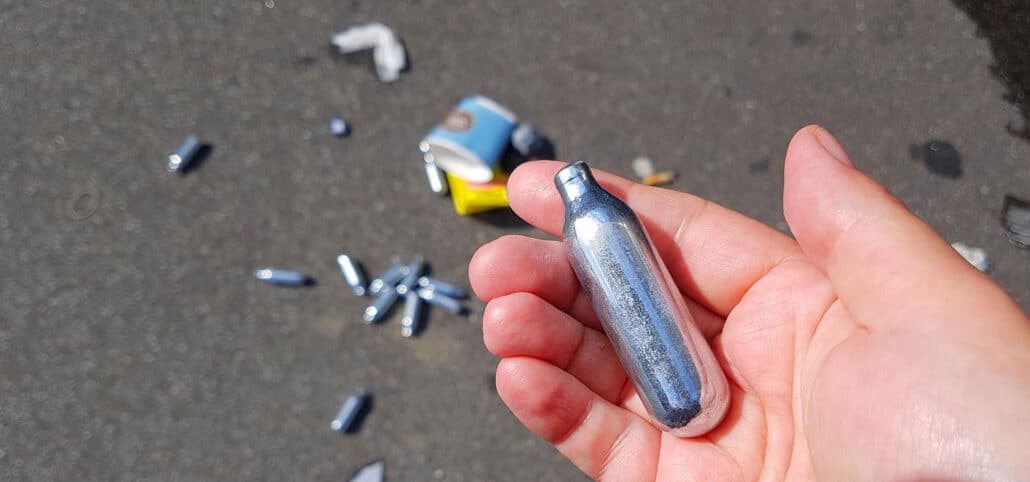Inhalants are aerosolized or volatile compounds that emit vapors and are found in many household products, including gases, nitrites, aerosol sprays, and solvents.[1] Some people inhale these substances to experience a high. When people use these substances as intended for household tasks, they are relatively harmless. However, when people abuse them by inhaling these substances, they can be dangerous. People who use inhalants for an extended period can suffer bone marrow disease, hearing loss, liver injury, and brain damage. Using an inhalant a single time can be fatal and cause asphyxia. It’s critical to be aware of the dangers of inhalants and the signs and symptoms that someone you love might be abusing these substances.

Table of Contents
- 1 What Is an Inhalant?
- 2 Statistics on Inhalant Use
- 3 How Do People Abuse Inhalants?
- 4 Inhalant Types/Classes
- 5 Can People Become Addicted to Inhalants?
- 6 What Are the Signs Someone is Abusing Inhalants?
- 7 What Is Inhalant Use Disorder?
- 8 Side Effects of Inhalant Abuse
- 9 Inhalant Overdose
- 10 Symptoms of Withdrawal
- 11 How Is Inhalant Abuse Treated?
- 12 Prevention of Inhalant Use
- 13 Get Help From Long Island Interventions
What Is an Inhalant?
Inhalants are volatile compounds that emit vapors and are cheap and widely available. When inhaled, these substances induce a sense of euphoria and mind-altering effects. Inhalants include a broad range of substances, including aerosol sprays, glue, paint thinner, gas, spray paint, and more. This means an inhalant doesn’t refer to a single type of recreational drug. However, all inhalants cause mind-altering effects when inhaled that encourage users to continue using them. While inhalant abuse isn’t as common as substance use disorders involving other drugs, people can still develop a substance use disorder when using inhalants. The compulsive abuse of inhalants can also have fatal consequences.
Many inhalants only cause a short period of intoxication, making abuse of these substances easier for users to hide than the abuse of other types of drugs. Products containing inhalants are easily accessible and commonly found in household cleaners and solvents, which makes them attractive to adolescents who do not have access to more expensive drugs.
Statistics on Inhalant Use
The 2021 National Survey on Drug Use and Health (NSDUH) found that an estimated 2.2 million Americans reported using inhalants at least once in the past year. Out of those, 626,000 were adolescents between the ages of 12 and 17. This cohort represented the largest age group abusing inhalants, and use decreased with age.[2]
The correlation between youth and inhalant use is especially troubling. The early use of inhalants can increase the risk that users will turn to other illegal drugs as they grow older. Abusing inhalants can also be fatal even when it is the first time.
How Do People Abuse Inhalants?
People abuse inhalants by doing any of the following things:
- Sniffing vapors from products in their containers
- Inhaling substances from plastic or paper bags after spraying the substance inside (bagging)
- Filling balloons with nitrous oxide and then inhaling from them
- Soaking cloths with inhalants and then placing the cloths over or in the mouth or nose before inhaling (huffing)
- Spraying aerosolized sprays directly into the nose or mouth[3]
When someone uses an inhalant, the high they experience might last for only a few minutes or up to an hour. However, many people will repeatedly use inhalants to achieve the same high. When people engage in repeated inhalant abuse, they can suffer from the effects of chronic exposure to the chemical compounds contained in inhalants.

Inhalant Types/Classes
Since inhalants include a broad range of chemical substances, they are classified into the following four categories:
1. Volatile solvents – These are vapor-emitting liquids at room temperature. Volatile solvents are found in gasoline, paint thinner, dry-cleaning liquid, glue, liquid correction products, and felt-tip markers.
2. Aerosols – These are substances that can be sprayed and contain propellants and solvents. Aerosols are found in products like spray deodorant, hair spray, spray paint, fabric protectors, and sprayable cooking oil.
3. Gases – These are substances found in commercial and household products and those used for medical procedures. Gases include things like nitrous oxide, ether, chloroform, refrigerants, butane lighters, propane tanks, and whipped cream spray cans.
4. Nitrites – These are substances that cause vasodilation and are typically used to alleviate cardiac symptoms and perform other medical procedures. Unlike other inhalants, nitrites do not directly affect the central nervous system but instead dilate blood vessels and relax muscles. Some examples of nitrites people might abuse include substances sold as room deodorizers, liquid aromas, leather cleaners, and video head cleaners.
Can People Become Addicted to Inhalants?
Inhalants are not considered to be addictive in the same way that other illicit substances are. However, people who repeatedly use inhalants can develop a tolerance and experience the need to use increasing dosages to achieve the same effects. Some people also report experiencing a need to continue their use of inhalants when they have abused them for a long time.[4] When people continue to abuse inhalants over a prolonged period, they have an increased risk of suffering severe health consequences, including seizures, overdose, coma, or death.
What Are the Signs Someone is Abusing Inhalants?
Many types of inhalants will not show up on regular drug tests, making it difficult to confirm whether someone has recently used them. Users can also easily conceal inhalant abuse, making it important for you to know the signs to look for that indicate your loved one could be abusing inhalants. A person who is abusing inhalants might show the following signs:
- Unexplained weight loss
- Muscular weakness
- Inattentiveness
- Disorientation
- Excitability
- Irritability
- Poor coordination
- Anxiety or depression
- Organ or central nervous system damage
- Stains or paint on clothing or the body
- Runny nose
- Red, watery eyes
- Sores around the mouth
- Dazed appearance
- Chemical odor on the breath
- Appetite loss
- Nausea[5]
If you think your loved one might be abusing inhalants, it’s important to seek help immediately. Continued inhalant use could cause lasting damage and could potentially lead to death.

What Is Inhalant Use Disorder?
Inhalant use disorder might be diagnosed when at least two of the following are present within 12 months:
- Using inhalants in successively greater amounts
- Being unable to stop or cut back despite wanting to
- Spending significant amounts of time trying to get, use, or recover from inhalants
- Having strong cravings to use inhalants
- Continuing to use inhalants despite their interference with the completion of school, work, or home responsibilities
- Being unable to stop using inhalants after doing so has caused problems in relationships
- Quitting or cutting back on previously enjoyed activities because of inhalant use
- Using inhalants in physically dangerous situations, including driving
- Developing a tolerance to inhalants and needing to use greater amounts to achieve the same effects
Side Effects of Inhalant Abuse
Inhalants act as central nervous system depressants and produce short-term effects similar to those occurring with alcohol use. Someone who has recently used inhalants might show the following symptoms in the minutes or up to an hour following their use:
- Slurred speech
- Feelings of euphoria
- Lightheadedness
- Headache
- Agitation
- Dizziness
- Drowsiness
- Poor coordination
- Excitability
- Blurry vision
- Nausea
- Irregular, rapid heartbeat that can cause sudden heart failure and death[6]
People who have abused inhalants over a prolonged period might show the following long-term effects:
- Damage to the kidneys and liver
- Damage to the lungs
- Loss of hearing
- weakened immune system
- Muscle spasms in the limbs
- Seizures
- Changes in heart rhythms
- Coma
- Death
Inhalant Overdose
People can overdose on inhalants. Aerosol sprays and solvents are especially dangerous because of their high concentrations of toxic chemicals. when people sniff or inhale these products, they can suffer seizures, coma, or sudden cardiac arrest. People can also suffocate when they breathe in inhalants from a plastic bag placed over their heads. People can also die from asphyxiation when inhaling fumes that replace oxygen in their lungs.
When someone overdoses on inhalants, medical professionals focus on treating the severe side effects caused by the overdose. There are no reversal agents that work with inhalants. Instead, medical professionals will do things to try to stop seizures or restart the heart.

Symptoms of Withdrawal
Withdrawal symptoms are uncommon with inhalants, but they can occur. Since inhalants include a broad range of substances, inhalant withdrawal doesn’t have one set of symptoms for all substances. However, some people do experience withdrawal symptoms when suddenly stopping their use of inhalants following three or more months of continued use. These symptoms can last from two to five days and might include the following:
- Irritability
- Altered mood
- Anxiety
- Sweating
- Trouble sleeping
- Appetite loss
- Nausea
- Muscular cramps
- Tingling sensations
- Seizures
- Tremors[7]
How Is Inhalant Abuse Treated?
Unlike other substance use disorders, people who abuse inhalants do not have any available reversal drugs to manage acute intoxication or the symptoms of withdrawal from inhalants. When someone is withdrawing from inhalants, they are typically treated in a controlled setting with supportive care, including a balanced diet, mental health and medical supervision, and enough sleep. Once the person has completed this initial phase, they will then be referred for comprehensive treatment.[8]
Inhalant abuse is treated using similar techniques as what are used to treat other substance use disorders. People might benefit from individual therapy, family therapy, activity programs, and support groups.
Cognitive-Behavioral Therapy
Many people recovering from inhalant use disorder benefit from cognitive-behavioral therapy (CBT). This is a talk therapy that teaches people to identify negative behavioral and thought patterns, address them, and change them to develop healthier coping mechanisms. CBT can help people cope with cravings and resist using inhalants.
Motivational Therapy
Some teens might benefit from motivational therapy, which is a counseling style used to help people gain the motivation to make positive changes.

Family Therapy
When adolescents use inhalants, family therapy can be helpful by improving the relationships, communication, and behaviors of all family members. This can help to provide strong support for the person recovering from inhalant abuse and their loved ones.
Activity Programs
Activity programs might also be helpful for people dealing with inhalant abuse. These programs provide people with new social experiences and skills to give them alternatives to inhalant use. Activity programs might include fun, positive activities that help people build prosocial skills, develop relationships, and engage in new relationships with people who don’t use substances.
Support Groups
Support groups can provide people recovering from inhalant use with support. Groups might help reduce the person’s risk of relapse and aid them in maintaining a life free from substance abuse.
Residential Treatment
People who have severe inhalant abuse disorders might be best treated in residential settings. These provide enhanced structure and support and are good choices for those who pose a risk to their own safety or that of others.
Prevention of Inhalant Use
Life skills training can help teens to avoid using inhalants. This includes teaching teens methods to increase self-esteem, improve communication skills, develop positive personal relationships, and manage stress and anxiety. Life skills programs are often delivered in school settings together with others targeting adolescent substance abuse.
Get Help From Long Island Interventions
If you suspect your teen or another loved one is abusing inhalants, it’s important to reach out for help immediately. Even a single use of inhalants can be fatal. The professional recovery team at Long Island Interventions can help you understand your treatment options and how to address your loved one’s inhalant abuse.
Please contact Long Island Interventions for information about Inhalant Addiction Treatment near you.
References
[1] https://nida.nih.gov/publications/research-reports/inhalants/what-are-inhalants
[2] https://www.samhsa.gov/data/sites/default/files/reports/rpt39443/2021NSDUHFFRRev010323.pdf
[3] https://nida.nih.gov/publications/research-reports/inhalants/how-are-inhalants-used
[4] https://www.ncbi.nlm.nih.gov/pmc/articles/PMC3188822/
[5] https://nida.nih.gov/publications/research-reports/inhalants/how-can-inhalant-abuse-be-recognized
[6] https://medlineplus.gov/inhalants.html
[7] https://www.ncbi.nlm.nih.gov/pmc/articles/PMC2787661/
[8] https://www.ncbi.nlm.nih.gov/pmc/articles/PMC10266853/

